Learn How to Climb Rope like a Navy SEAL and Build Functional Strength
Learn How to Climb Rope like a Navy SEAL and Build Functional Strength
So why should you climb rope? First of all, if you’re not including rope climbing in your routine, you’re missing out on one of the best forearm and grip workouts around.
Climbing rope is also at the core of the Functional Strength discussions we’ve had here on ITS. Just as we advocate being able to physically save yourself; rope climbing has a large carry-over to training the same muscles you’d need to pull or lift yourself to safety.
Sourcing a Rope to Climb
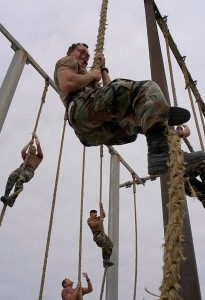 If you’ve never attempted to climb rope before, don’t worry; I’ll address that below. The first step in progressing into climbing rope is an obvious one. Get yourself a rope! There are a couple of options I’ll recommend here.
If you’ve never attempted to climb rope before, don’t worry; I’ll address that below. The first step in progressing into climbing rope is an obvious one. Get yourself a rope! There are a couple of options I’ll recommend here.
Manilla Rope
The first option is to purchase a good natural fiber Manilla rope that’s at least 1 1/2″ to 2″ in diameter and 20 ft. long. I found a fairly good deal on Amazon for a 30 ft. 2″ diameter Manilla rope for $150. The only issue I see with buying something like this is the attachment method and I’d recommend cutting one end off and creating an eye splice.
By creating an eye splice (just like we did in our Fast Rope article) in one end it will allow you to climb a tree in a park or your backyard and girth hitch it over a branch to start climbing. The downside to using a Manilla rope is that it will fray over time as you can see in the photo to the right!
Fast Rope
The second option, which I highly recommend, is to make your own Fast Rope. By following our article series and making your own Fast Rope, you’ll not only gain the practice of tying a multitude of knots, saving money and building something awesome, but have a climbing rope that will last much longer than a natural fiber rope.
There are sometimes auctions on eBay too for used Military Fast Ropes, but they’re usually very worn and you won’t know the history behind the rope or how stable it is.
Climbing Techniques
There are three different techniques I’m going to address today, below you can watch a video of each of these being used and see why I prefer to climb with the brake and squat technique I was taught in BUD/s. You should also climb in pants and boots to save your shoes and legs from rope abuse.
While any of these techniques I’ll explain below will allow you to climb a rope, there’s only one I’m going to recommend based on speed, fast reacquisition of the rope and energy savings.
Gym Class Technique
The first technique I’ll address is the typical way I see people climb rope that have never been properly taught how climb. I call it the gym class technique, because if you’re like me and went to elementary school before schools were afraid of being sued, you probably used this technique to get up the rope.
Gym class technique is where you pinch the rope between your feet and reach up with your hands to pull up on the rope and repeat. While you can manage to get up a rope using this technique, you’re working twice as hard. With any technique, the goal should be to use your legs to get up the rope and not depending on upper body strength.
That’s not to say upper body strength isn’t important or needed to climb, it’s just to say that your legs should contribute and not just hold the rope.
Brake and Squat (Marine Style)
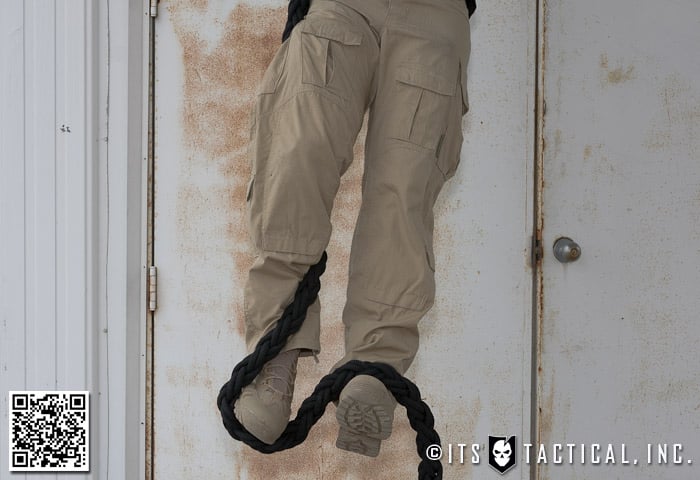
Marine style brake and squat is what the Marines teach in boot camp; while effective, it’s not a very quick technique and can cause you extra work by having to reacquire the rope if you lose the wrap. With any brake and squat technique the goal is to work your way up the rope by using your feet to put the brakes on the rope in a squatted position and simply stand up, reach as far up as you can and repeat.
The technique for the Marine style brake and squat is as follows. First you jump up with your arms extended, letting the rope either fall between your thighs or to the outside (I’ve seen both). From there you single wrap the rope around one of your legs and across the top of your boot. The boot of the unwrapped leg clamps down on the other boot, trapping the rope. You can now support your weight without using the power of your arms and hands.
I don’t personally care for this method, because as mentioned above, you have to re-wrap the rope around your leg if it’s not feeding through your legs as you climb up. This can lead to extra work and getting beat when racing a buddy.
Brake and Squat (BUD/s Style)
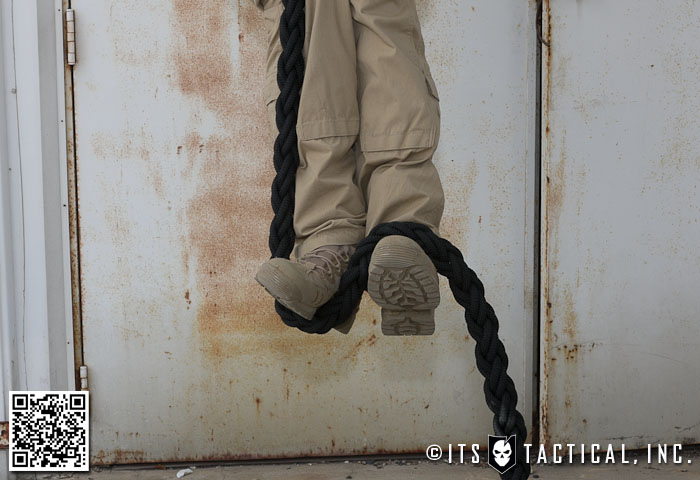
During BUD/s I was taught to use a very simple brake and squat technique that’s extremely fast, easy to reacquire the rope and will beat any other technique for speed. We’d have team rope climb races all the time and it would always be the guys using the Marine style brake and squat technique (despite being taught otherwise) that would slow a team down and cause them to hit the surf. It pays to be a winner!
All there is to the BUD/s style technique is to jump up to grab the rope high letting the rope to fall on the outside of a leg. With the leg that the rope falls to, simply step on it by using the opposite foot to help. The combination of the rope falling across the top of the opposite foot and stepping on the rope with the other foot will lock the rope in place.
The idea here is to always reach up as high as you can before you “squat” your feet back up the rope and reacquire, standing up to gain more height. The quickest guy I ever saw climb rope at BUD/s seriously looked like his feet would reach all the way to his chest before he’d stand up. It was truly amazing to watch.
You can stand in this position all day and take some of the work off your arms. Coming down from the rope is super simple as well, just relax the tension with your feet as you descend and the rope will flow through your feet easily.
Beginner’s Tips
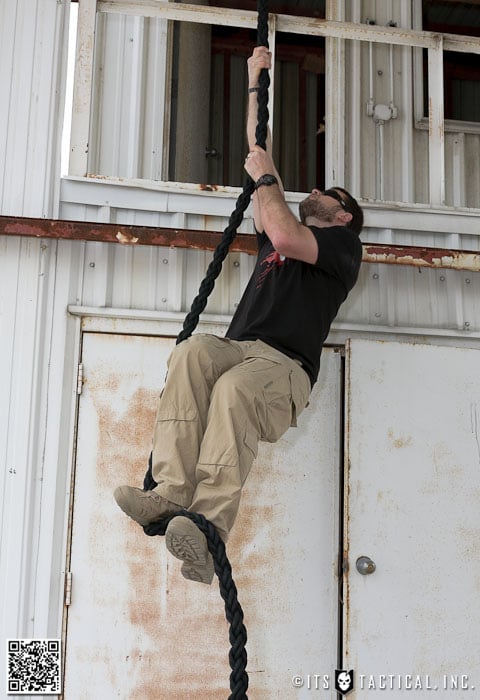 If any of these techniques are more than you can physically master, start slow. You can work on the upper body strength needed to climb rope by using your rope to do pull-ups or even throwing a towel over a pull-up bar and doing towel pull-ups, as this will work the same muscles. For technique work, simply get on the rope and practice locking it in with your feet.
If any of these techniques are more than you can physically master, start slow. You can work on the upper body strength needed to climb rope by using your rope to do pull-ups or even throwing a towel over a pull-up bar and doing towel pull-ups, as this will work the same muscles. For technique work, simply get on the rope and practice locking it in with your feet.
Advanced Techniques
A few other techniques you can use to climb are climbing without your legs, climbing without your legs from an L-Sit position at the bottom of the rope and even climbing two ropes side by side without your feet. I find that I have the hardest time with the L-Sit technique, as I figure my core is weak in that area or my technique just sucks!
Climbing without your legs is an intense forearm, bicep and back workout. It requires excellent grip strength and not being afraid of heights! I’ve successfully climbed two ropes without using my feet, one in each hand. Let me tell you though, it’s not an easy thing to do! I had a few close calls trying to climb like this and nearly fell twenty or so feet attempting it. Be careful if you decide to attempt the advanced techniques!
Workouts
While pretty self explanatory, in terms of workouts, the best thing to do is to incorporate a number of rope climbs into your workout routine. When I have access to a rope, I’ll usually throw in pushups, situps, dips, air squats and a rope climb or two into 3-5 sets. You can even use the pyramid workout I outlined in the Pull-up functional strength article and sub in rope climbs for pull-ups.
You can also figure on subbing in 15 pullups for every rope climb, it’s definitely not the same movement as a rope climb, but is the closest movement and repetition count to climbing a 20 to 30 foot rope.
Video
Disclaimer
Climbing ropes is inherently dangerous should your grip give out while you’re on the rope. Use caution and know your limitations before you get too high and can’t hold on any longer!
I hope you enjoyed this look at rope climbing techniques, be sure to leave any questions or comments below and let everyone know what kind of rope climbing you’ve worked into your workouts!






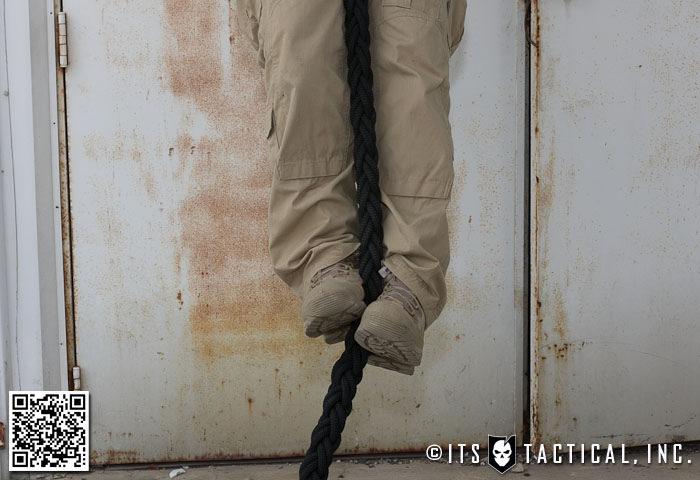
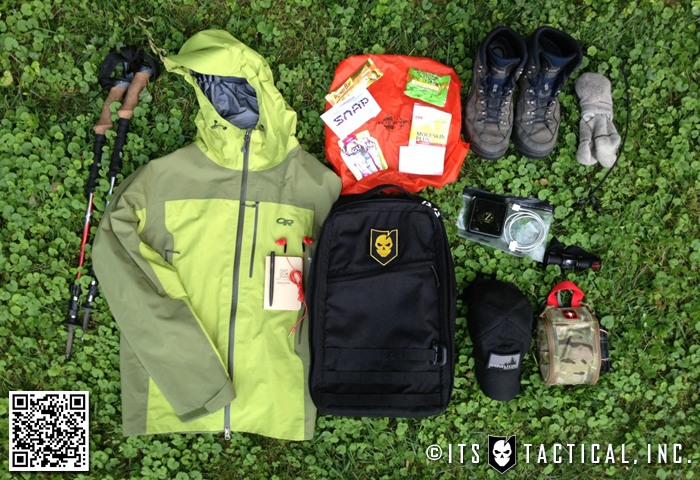
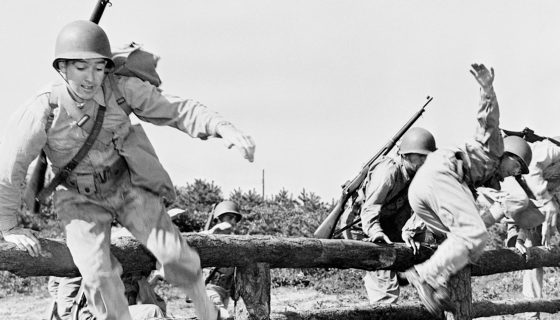
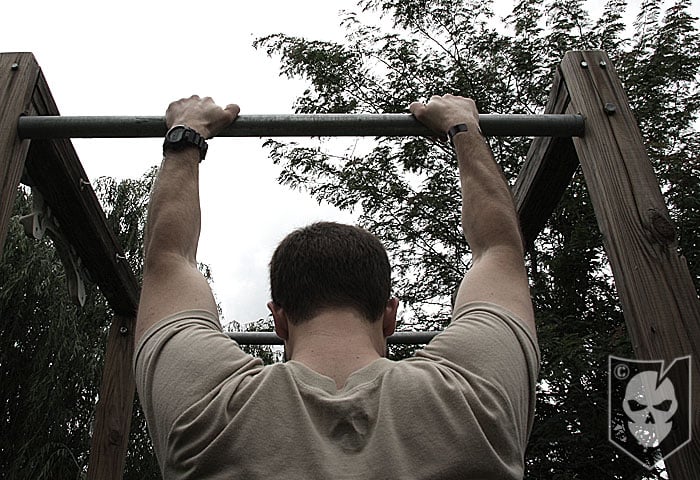


Discussion